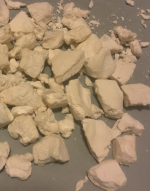- Joined
- Dec 29, 2021
- Messages
- 102
- Reaction score
- 39
- Points
- 18
Here was what i did on a smaller scale;
1. Solution IPA/H2O 2:1 ((IPA 800ml,H2O 400ml)(1200ml)) was added a 2000ml flask.
2. NaBH4 (116 g) was added at once and stirring was started.
3. P2NP (67 g) was added in small portions, so that the temperature of the mixture did not exceed 60 *С.
4. CuCl2 (7 g) in water (13 ml) was added slow dropwise, so that the temperature of the mixture did not exceed 80 *С.
5. Thereafter, reaction was refluxed at 80 °C for 30 minutes using external heating.
6. Solution is decanted and filtered from reaction waste and put into a seperatory funnel.
7. 25% water solution of NaOH (533ml) was added to reaction mixture and the phases were separated.
8. Drain the bottom layer into a large beaker and collect the top organic layer.
9. The aqueous phase was then put into the seperatory funnel and extracted with 500ml of IPA.
10.IPA was evaporated by 3/4, half milky freebase and half IPA.
11.The IPA and freebase was dissolved in 130ml of acetone.
12.orthophosphoric acid dripped to pH - 6 (with constant stirring).
13.The mixture was put in the freezer for 12 hours.
14.After crystallisation the suspension was filtered and washed with dry cold acetone, until acetone is clean.
15.Acetone from washing and the ipa/acetone mix is placed back into freezer for further precipitation.
16.Process repeated until no more precipitate to yield 60-70% high quality amphetamine, as the mix gets more acetone in it you may need to drip some more acid to bring it down, but not too much as acetone is ph7.
Here is a photo of some of the dried paste rocks , the rest is dry powder to be mixed, as it is too strong for me and my friends.
I may update the recipe and do a write up for the small scale home chemist, there are lots of ways this could be better.
1. Solution IPA/H2O 2:1 ((IPA 800ml,H2O 400ml)(1200ml)) was added a 2000ml flask.
2. NaBH4 (116 g) was added at once and stirring was started.
3. P2NP (67 g) was added in small portions, so that the temperature of the mixture did not exceed 60 *С.
4. CuCl2 (7 g) in water (13 ml) was added slow dropwise, so that the temperature of the mixture did not exceed 80 *С.
5. Thereafter, reaction was refluxed at 80 °C for 30 minutes using external heating.
6. Solution is decanted and filtered from reaction waste and put into a seperatory funnel.
7. 25% water solution of NaOH (533ml) was added to reaction mixture and the phases were separated.
8. Drain the bottom layer into a large beaker and collect the top organic layer.
9. The aqueous phase was then put into the seperatory funnel and extracted with 500ml of IPA.
10.IPA was evaporated by 3/4, half milky freebase and half IPA.
11.The IPA and freebase was dissolved in 130ml of acetone.
12.orthophosphoric acid dripped to pH - 6 (with constant stirring).
13.The mixture was put in the freezer for 12 hours.
14.After crystallisation the suspension was filtered and washed with dry cold acetone, until acetone is clean.
15.Acetone from washing and the ipa/acetone mix is placed back into freezer for further precipitation.
16.Process repeated until no more precipitate to yield 60-70% high quality amphetamine, as the mix gets more acetone in it you may need to drip some more acid to bring it down, but not too much as acetone is ph7.
Here is a photo of some of the dried paste rocks , the rest is dry powder to be mixed, as it is too strong for me and my friends.
I may update the recipe and do a write up for the small scale home chemist, there are lots of ways this could be better.
Attachments
- Joined
- Jul 2, 2023
- Messages
- 17
- Reaction score
- 9
- Points
- 3
this is no meth , can you write from here on how to make it to crystal meth
- Language
- 🇺🇸
- Joined
- Oct 27, 2024
- Messages
- 31
- Reaction score
- 8
- Points
- 8
A different process. P2P or sudo. Just pick one. But these are safer imo


